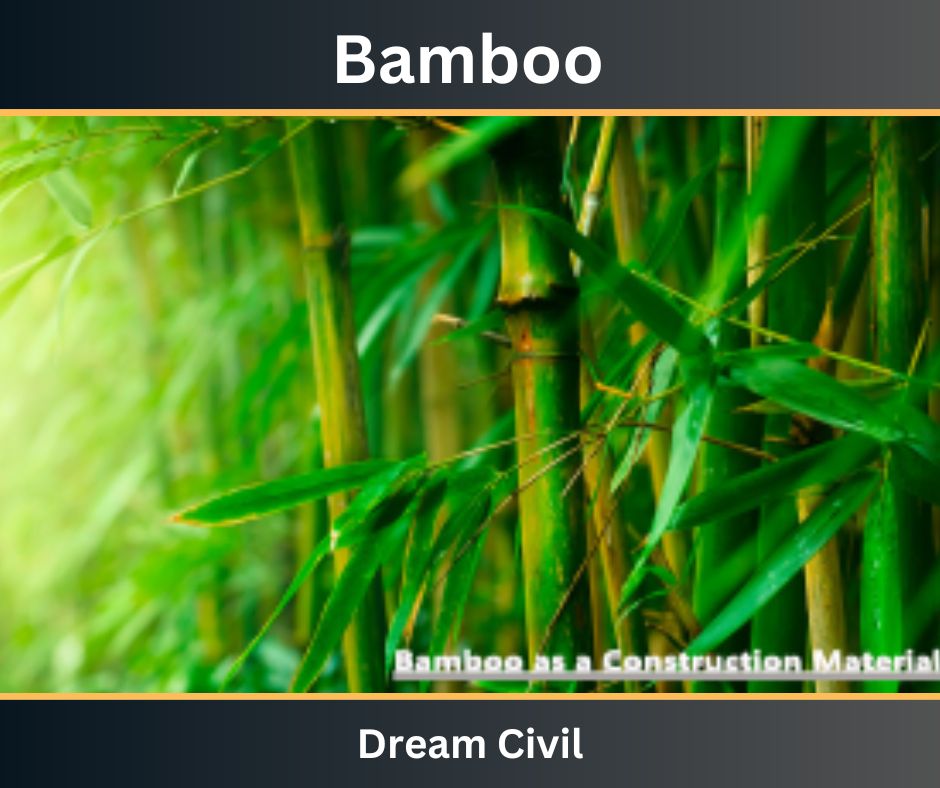Table of Contents
Bamboo is a giant woody fast-growing plant having a hollow jointed stem with high compressive and tensile strength.
In this article, we will learn about bamboo as a construction material.
Bamboo of age 3-6 years are favorable for construction purposes.
Due to its properties of greater strength, high flexibility, lightweight, easy workability, and availability; it is widely used in the construction field.
Bamboo has very strong fiber with compressive strength twice the of concrete and tensile strength near to steel. It can be curved without breaking due to the strong and flexible fiber present in it.
Because of these advantageous physical and strength characteristics, bamboo is suitable material for the application in different types of structures and constructions.

1. History: Bamboo as a Construction Material
In ancient times, bamboo used in its natural form is seen to be associated with the cultures of South Asia, East Asia, the South Pacific, Central, and South America.
As time passes, it started to be used for supporting various suspension bridges, skyscrapers, and ladders, as architecturally designed masterpieces to give a smooth aesthetic finishing look as fencing, gates, gutters, fountains, etc., and so on.
After many significant kinds of research on elements and joints, the first structural design codes for bamboo were published by ISO in 2004 under its physical, mechanical, and structural properties which leads to the modern and advanced use of bamboo in construction workshops.
2. Applications of Bamboo as a Construction Material
Some applications of bamboo as a construction material are:
a. Bamboo Trusses:
Bamboo is light in weight, flexible, ductile, and strong. So, it can be easily used for the construction of trusses at a low cost.
For making frames; properly seasoned/ dried straight bamboo are utilized.
For roofing; Corrugated Bamboo Roofing Sheets can be utilized.
b. Bamboo walls:
Bamboo can be utilized for making bamboo walls. They should be protected from moisture using (2-3) coats of rubber tree oil before application.
c. Bamboo doors and windows:
For a sustainable and economically accessible aesthetic interior look; bamboo has been used in framing doors, windows, and balconies by weaving bamboo strips as matting or a palm leaf.
d. Bamboo Roofing:
Bamboo can be laminated into sheets and flattened by splitting large culm.
Corrugated Bamboo Roofing Sheets are available in the roofing market.
e. Bamboo as Reed Boards:
Bamboo can be used in place of reed boards which are mainly used for thermally insulating ceilings and interior walls.
Reed boards are generally made from natural reeds having rigid jointed hollow stem-like bamboo.
f. Scaffolding:
Because of properties like lightweight, easy transportation, low cost, flexibility, and high strength; bamboo is widely used as scaffolding.
Bamboo is utilized as scaffolding in the construction of small structures ( buildings, culverts, etc) to heavy structures ( Bridges, Skyscrapers, etc).
g.Erosion control:
In many flood or landslide-prone areas; bamboo can be installed as retaining materials.
It is more secure to harvest bamboo near to river bank as it holds the soil strongly not letting it erode with high-velocity flow water.
h. Structural Reinforcement:
Bamboo has an essential structural behavior.
The placement of bamboo as a structural reinforcement is similar to iron/steel reinforcement rods in concrete.
3. Some Precautions to Apply Before Using Bamboo
a. Even a small amount of defect (decay) due to natural toxins or beetle/termite / fungal attack can bring change in the strength capacity of bamboo.
b. Bamboo must be kept dry throughout its use to maintain the tensile and compressive strength of its fiber.
c. Bamboo’s quality should be tested using different methods to prevent upcoming hazards and damage during designation and after construction.
d. Uniformity in length and diameter of bamboo should be considered properly that is to be used in the construction.
e. Public awareness should be given that it is just a myth/misconception that bamboo is inferior wood incapable to be used to provide strength to the structure.

4. Advantages of Using Bamboo as a Construction Material
Some merits of bamboo as a construction material are:
a. Bamboo can be curved:
It is a fast-growing plant with high tensile fibers. Thus, with adequate heat and pressure, it can be curved/bent up to a certain limit of extension. It is flexible in nature.
b. It has a non-linear stress-strain behavior.
c. It is more durable compared to other kinds of wood items if prevented from decaying and exposure to moisture and fungi for a long time.
d. It has energy-absorbing and higher bending strength that can be ideally used for seismic-resistant construction.
e. It is easily available and can be repaired, handled, cut, maintained, and repositioned due to its lightweight.
f. It is an eco-friendly construction material.
g. It can be used for a retaining purpose near river banks to check overflow of water preventing erosion of bank soil.
h. For architectural decorations and design; bamboo gives an enhancing look to structures. Thus, it is economically accessible.
I. It is easy to transport, store and handle.
j. By cutting stalks of bamboo into thin strips and drying them, it can be laminated into sheets and planks. These sheets and planks have been used in flooring cabinetry, furniture, and decoration purposes at present.
k. It is fire-resistive in nature due to the presence of a high value of silicate acid and water.
l. It poses no danger to health.
5. Disadvantages of Bamboo as a Construction Material
Some demerits of bamboo are:
a. Requirement of preservation.
b. It shrinks greater when loses water.
c. For making it durable; lots of treatments are required.
d. Reliability of bamboo is questionable despite its lightweight, high strength, and ductility.
6. References1. Content Filter & Authenticity Checking Team, Dream Civil International (Our team checks every content & detail to maintain quality.) |
Read Also: Hempcrete

